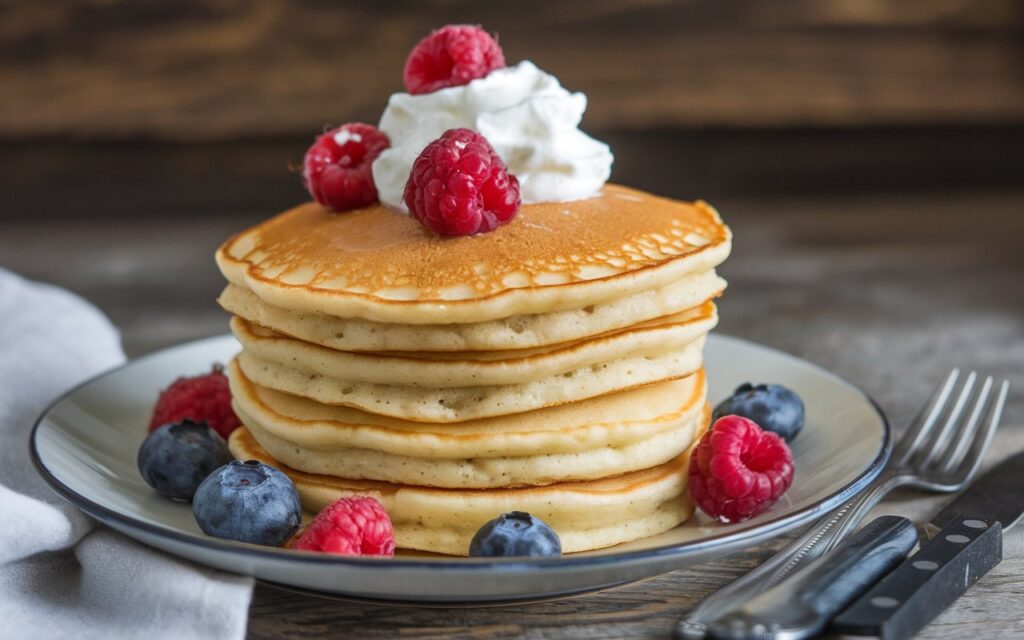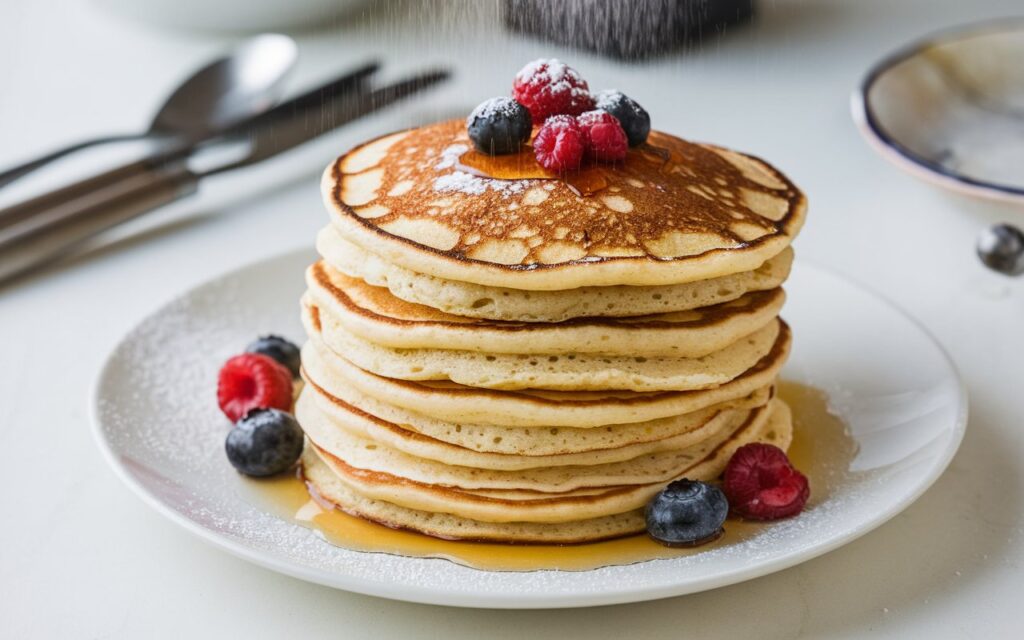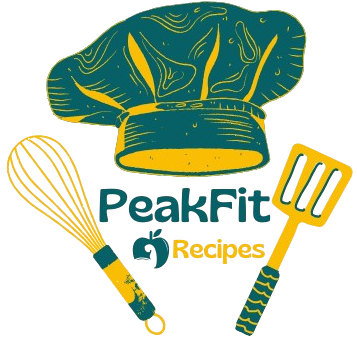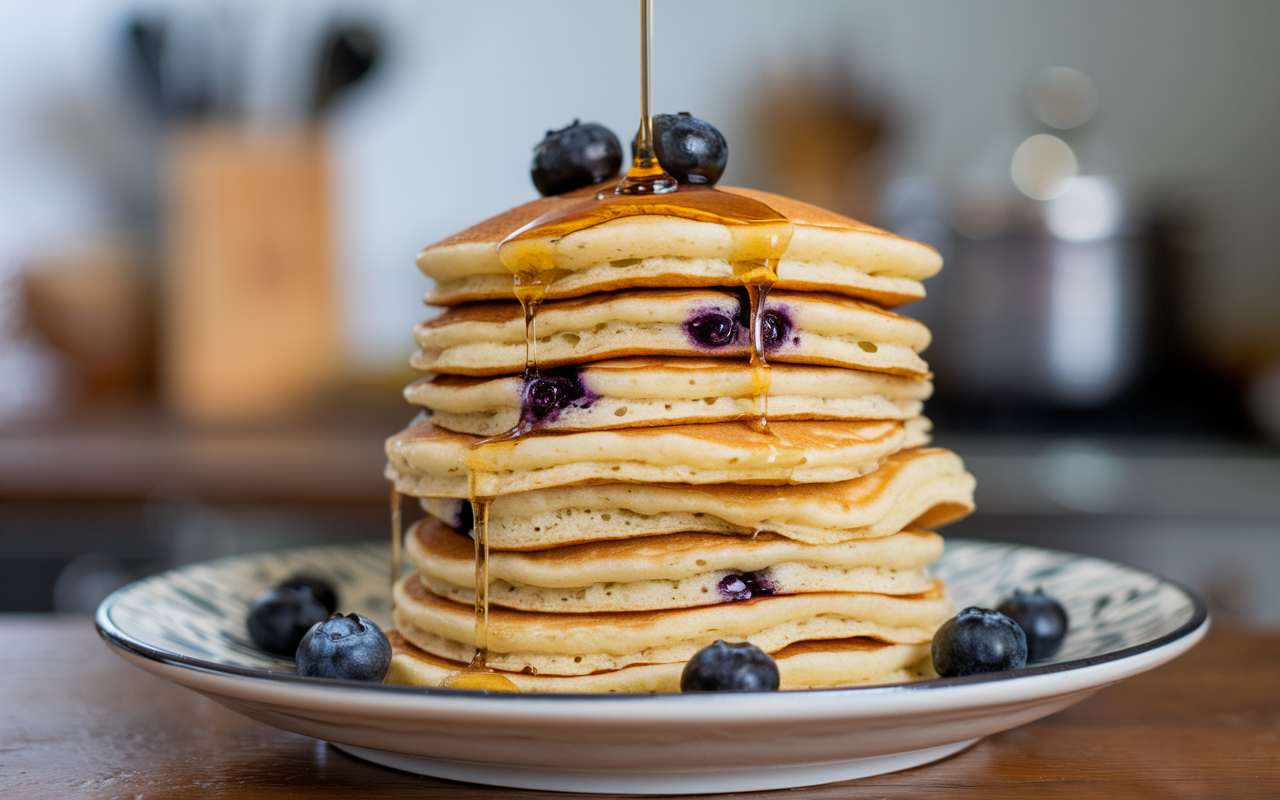Pancakes are a breakfast staple that most of us enjoy for their fluffy and comforting texture. But what happens when you’re out of milk? Can you use water instead of milk for pancakes? The answer is yes, but there’s more to it than just substituting one liquid for another. In this article, we’ll explore how water impacts pancake recipes, tips for making the best pancakes with water, and other substitutes to consider.
Why Milk Is Traditionally Used in Pancakes
Milk is a common ingredient in pancake recipes because it contributes to texture, flavor, and richness. Here’s why milk is often preferred:
- Moisture: Milk hydrates the dry ingredients and helps create a smooth batter.
- Flavor: Its natural sugars and fats enhance the flavor of pancakes.
- Binding Agent: Milk works with other ingredients to bind the batter, ensuring the pancakes hold their shape.
- Browning: The sugars in milk encourage browning during cooking, giving pancakes their golden color.
However, even if milk plays a key role, it’s not irreplaceable. Using water as a substitute can still yield delicious results with a few adjustments.
Can You Use Water Instead of Milk for Pancakes?
Yes, you can substitute water for milk in pancake recipes. While the final result may differ slightly, the pancakes will still cook properly and taste good. Here’s how the two compare:
- Texture: Pancakes made with water tend to be lighter and less rich than those made with milk.
- Flavor: Without milk’s natural sugars and fats, the flavor might be milder. Adding a splash of vanilla extract or a teaspoon of sugar can help compensate.
- Appearance: The lack of milk sugars might mean the pancakes won’t brown as much, but this won’t affect their taste.
Tips for Making Pancakes with Water
If you’re planning to use water instead of milk for pancakes, follow these tips to ensure the best results:
1. Add Flavor Enhancers
Since water lacks the richness of milk, try adding one or more of the following:
- Vanilla Extract: A small amount enhances the pancake flavor.
- Cinnamon or Nutmeg: These spices can add depth to your pancakes.
- Sugar or Honey: Just a teaspoon can make a difference in taste.
2. Adjust the Consistency
Water-based pancake batter might be thinner than usual. To fix this, reduce the amount of water slightly or add an extra tablespoon of flour.
3. Use Butter or Oil
Incorporating melted butter or a splash of oil into the batter adds richness and helps mimic the creaminess of milk.
4. Be Patient While Cooking
Pancakes made with water might take slightly longer to brown. Cook them on medium heat to ensure even cooking without burning.
Substitutes for Milk in Pancakes
If you’re out of milk and wondering what else you can use besides water, here are some great alternatives:
1. Non-Dairy Milks
- Almond Milk: A light and nutty flavor.
- Oat Milk: Creamy with a subtle sweetness.
- Soy Milk: A rich and protein-packed option.
2. Dairy Alternatives
- Yogurt: Thin it with water for a milk-like consistency.
- Sour Cream: Works well for thicker, tangy pancakes.
- Buttermilk Substitute: Mix one tablespoon of vinegar or lemon juice with a cup of water.
3. Juices or Carbonated Water
- Orange Juice: Adds a citrusy flavor, perfect for breakfast pancakes.
- Carbonated Water: Creates fluffier pancakes due to the added bubbles.

How Water Impacts Pancake Mixes
Pre-made pancake mixes are convenient, but can you use water instead of milk for Bisquick pancakes or other mixes? Most store-bought mixes are designed to work with either milk or water. However, pancakes made with water might have a slightly less rich flavor. To enhance the taste, consider adding:
- A teaspoon of sugar or a drizzle of maple syrup.
- A dash of vanilla extract or cinnamon.
Always check the instructions on the package, as some mixes may include specific recommendations for water-based recipes.
The Science Behind Pancake Texture
Pancake texture depends heavily on the liquid used. When you use water instead of milk, it alters the batter’s properties:
- Moisture: Water hydrates the batter but lacks the fats and proteins in milk, resulting in lighter pancakes.
- Structure: Milk proteins strengthen the pancake structure, so water-based pancakes may be softer.
- Flavor: Without milk’s natural sweetness, water-based pancakes may taste blander.
To learn more about how ingredients affect baked goods, check out this guide on pancake chemistry.
Creative Pancake Recipes with Water
If you’re using water as your liquid base, you can still create exciting pancake recipes:
- Savory Pancakes: Add grated cheese, herbs, and spices to the batter.
- Vegan Pancakes: Combine water with mashed bananas or applesauce for natural sweetness.
- Chocolate Pancakes: Stir in cocoa powder and a handful of chocolate chips.
For more inspiration, explore our Creative Pancake Recipe Ideas for unique twists.
Nutritional Comparison: Milk vs. Water in Pancakes
Curious about the nutritional differences? Here’s a quick comparison:
- Calories: Water has zero calories, while milk adds about 100 calories per cup.
- Protein: Milk contributes 8 grams of protein per cup, which water lacks.
- Micronutrients: Milk adds calcium, potassium, and vitamin D, which are missing in water.
For a detailed breakdown of milk substitutes, visit Harvard’s Nutrition Source.
Adapting Pre-Made Pancake Mixes with Water
Most pancake mixes are highly adaptable. If you’re using water instead of milk:
- Enhance Flavor: Add a teaspoon of sugar or a dash of vanilla.
- Improve Texture: Mix in a tablespoon of melted butter for added richness.
- Increase Fluffiness: Use sparkling water instead of still water for a lighter batter.
For other tips on cooking with pre-made mixes, check out our article on Best Pancake Hacks.
How to Store and Reheat Pancakes Made with Water
Pancakes made with water store well, making them ideal for meal prep:
- Storage: Let pancakes cool completely, then stack them with parchment paper between layers. Store in an airtight container in the refrigerator for up to 5 days.
- Freezing: Freeze pancakes in a resealable bag for up to 3 months.
- Reheating: Warm pancakes in a toaster or oven to restore their original texture.
For more storage tips, see our Guide to Storing Pancakes.
The Role of Other Ingredients in Pancakes
When you substitute water for milk, other ingredients take on a more prominent role:
- Eggs: Help bind the batter and provide structure.
- Flour: Absorbs the liquid and creates the pancake base.
- Leavening Agents: Baking powder or soda ensures fluffy pancakes, regardless of the liquid used.
To learn about how to adjust pancake recipes, check out this helpful baking resource.

Frequently Asked Questions (FAQs)
What can I use if I don’t have milk for pancakes?
You can use water, non-dairy milk, yogurt, or even fruit juices as a substitute. Each option will affect the texture and flavor differently.
Can you use water instead of milk for Bisquick pancakes?
Yes, water works perfectly with Bisquick pancake mix. To enhance the flavor, consider adding vanilla extract or a pinch of sugar.
Can you substitute water for milk?
Yes, water can replace milk in most recipes, including pancakes. However, the dish may be less creamy and flavorful.
Can I just add water to pancake mix?
Most pancake mixes are versatile enough to work with just water. For a richer flavor, you can add butter, oil, or vanilla extract to the mix.
Can I make pancakes without milk and eggs?
Yes, you can! Use water and a flaxseed or chia seed substitute for eggs to create vegan pancakes.
What happens if I add too much water to pancake batter?
Adding too much water makes the batter runny, leading to thin, uneven pancakes. Reduce water or add flour to fix the consistency.
Can sparkling water make pancakes fluffier?
Yes, sparkling water adds carbonation, which helps create a light and airy pancake texture.
Using Water Instead of Milk: Practical Considerations
Substituting water for milk in pancakes may require small adjustments. Here are some practical considerations to keep in mind:
- Measuring Ingredients: Use the same quantity of water as the recipe specifies for milk unless the batter feels too thin.
- Mixing Technique: Stir gently to avoid overmixing, which can make pancakes dense.
- Cooking Time: Water-based pancakes may cook faster or slower, so keep an eye on them to prevent burning.
Flavor Variations with Water-Based Pancakes
While using water instead of milk, you can experiment with flavors to elevate your pancakes:
- Citrus Twist: Add a teaspoon of lemon or orange zest to brighten the flavor.
- Spice It Up: Try cinnamon, nutmeg, or ginger for a warm, aromatic touch.
- Sweet Add-Ins: Stir in a handful of chocolate chips, dried fruits, or shredded coconut for extra sweetness.
These variations ensure that your pancakes remain flavorful and exciting.
Water vs. Other Substitutes in Pancakes
Water is just one of many substitutes for milk in pancakes. Here’s how it compares to other options:
- Almond or Soy Milk: These add creaminess and a slight nutty flavor.
- Juice: Orange or apple juice provides sweetness but can alter the batter’s consistency.
- Broth or Stock: For savory pancakes, a light vegetable or chicken stock works well.
Understanding the characteristics of each substitute helps you tailor your pancakes to your preference.
Common Mistakes to Avoid When Using Water
When using water instead of milk, avoiding these mistakes can improve your pancake experience:
- Too Thin Batter: Adding too much water can make the batter runny. Adjust by adding more flour if needed.
- Skipping Oil or Butter: Omitting fat can make pancakes dry. Incorporate melted butter or a neutral oil.
- High Heat Cooking: Cooking on high heat may result in unevenly cooked pancakes. Opt for medium heat instead.
By being mindful of these common pitfalls, you can ensure consistently good results.
Historical Perspective: Pancakes Without Milk
Historically, pancakes were made without milk in many cultures due to limited access to dairy products. These traditional recipes often relied on water or other liquids:
- Flatbreads: Some pancakes originated as unleavened flatbreads made with flour and water.
- Cultural Variations: Many cuisines, like Japanese okonomiyaki or Ethiopian injera, use non-dairy liquids for pancakes.
- Modern Adaptations: With more substitutes available today, it’s easier than ever to customize pancake recipes.
This historical insight highlights the adaptability of pancakes across time and cultures.
Kid-Friendly Pancakes Made with Water
Pancakes made with water can still be a hit with kids. Here’s how to make them more appealing:
- Shapes: Use cookie cutters to create fun pancake shapes.
- Toppings: Offer a variety of toppings like berries, whipped cream, or sprinkles.
- Mini Pancakes: Smaller, bite-sized pancakes are easier for kids to handle and enjoy.
These playful touches make breakfast exciting, even without milk.
Can Water-Based Pancakes Be Healthy?
Yes, using water instead of milk can make pancakes a healthier option:
- Lower Calories: Eliminating milk reduces calorie intake without compromising basic nutrition.
- Customizable Additions: You can add fresh fruits, whole grains, or seeds for a nutrient boost.
- Control Over Sweetness: Without milk’s natural sugar, you can decide how much sweetness to add.
This approach allows you to enjoy pancakes guilt-free while meeting dietary goals.
Pancake Pairings: What to Serve with Water-Based Pancakes
Pairing your pancakes with the right sides can enhance the meal:
- Sweet Pairings: Fresh fruit, maple syrup, or a dollop of yogurt work wonderfully.
- Savory Pairings: Scrambled eggs, bacon, or sautéed vegetables balance out the meal.
- Beverages: Pair with coffee, tea, or a glass of freshly squeezed juice for a complete breakfast.
These combinations ensure that your meal is satisfying and well-rounded.
Benefits of Using Water in Pancakes
Choosing water instead of milk for pancakes has its advantages:
- Accessibility: Water is readily available, making it a convenient substitute.
- Cost-Effectiveness: It’s a budget-friendly option, especially for those looking to save on grocery expenses.
- Lighter Pancakes: Water-based pancakes tend to be lighter, which some people may prefer.
These benefits demonstrate that water can be a practical and effective choice in pancake recipes.
Advanced Techniques for Perfect Water-Based Pancakes
To achieve the best results with water-based pancakes, try these advanced techniques:
- Rest the Batter: Let the batter rest for 5-10 minutes before cooking to allow the ingredients to fully hydrate.
- Use a Hot Griddle: Ensure the griddle is evenly heated before adding batter for consistent cooking.
- Layer Flavors: Add extracts, spices, or zest to the batter for a more complex flavor profile.
These techniques elevate your pancake game and ensure success, even with water as the liquid base.
Conclusion
Can you use water instead of milk for pancakes? Absolutely! While pancakes made with water may lack the richness that milk provides, they can still be delicious and satisfying. By making small adjustments, such as adding flavor enhancers or adjusting the batter consistency, you can create pancakes that are just as enjoyable. The next time you’re out of milk, don’t let it stop you from enjoying a stack of fluffy pancakes.

